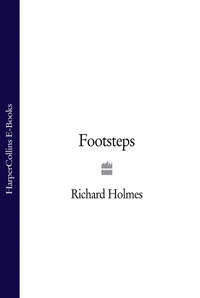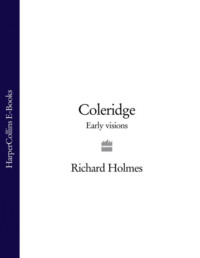
Полная версия
Footsteps
As I followed him, I was aware of a man possessed, shut in on himself, more and more difficult to make contact with. The narrative of the trip became at the same time more intense, more beautiful, and on occasions almost surreal. His wayside meetings were fewer, but obviously more significant to him. The general descriptions take on a visionary quality: strangely awestruck meditations on the huge, shadowy chestnut trees overhanging his route; the dusty track glowing eerily white under the moon (it is noticeable how often now he seems to be travelling after dark); a solemn night spent high up amidst the pines on the side of Mont Lozère; another deeply troubled camp with drawn pistol on the precipitous terraces above the gorge of the Tarn; and a period of black depression walking through the deserted valley of the Mimente below Mont Mars:
But black care was sitting on my knapsack; the thoughts would not flow evenly in my mind; sometimes the stream ceased and left me for a second like a dead man; and sometimes they would spring up upon me without preparation as if from behind a door … the ill humours got uppermost and kept me black and apprehensive. I felt sure I must be going to be ill; and at the same time, I was well aware that a night in the open air and the arrival of holy and healthy dawn would put me all right again with the world and myself.
The moody fluctuations of this entry are typical: the way the real river has become confused with the inward stream of his thoughts; the way the knapsack has become a more than physical weight; the way he longs for a “holy and a healthy” dawn. These were all, I knew, symptoms of the solitary walker travelling too long alone in high bare places. But for Stevenson they had a special source, a specific pain. Introspection had reached a critical point, and I was hardly surprised to discover one entry which refers to “this disgusting journal”. I followed him now with a kind of trepidation.
Over the first of the “high ridges”, the Montagne du Goulet, Stevenson abandoned the zigzag donkey track, and tried to push Modestine straight up through the trees, beating her—“the cursed brute”—with a savagery he later shamefully regretted. She was bleeding frequently now “from the poop”, but it seems to have been some time still before he realised she was on heat. He crossed over the high bare crest, marked only by upright stones posted for the drovers, and came down to Le Bleymard, tucked in the valley, with “no company but a lark or two”.
I crossed the same ridge shortly after dawn, having spent the night on a corner of the village green at L’Estampe, observed by a patient farm dog, who accompanied me almost all the way up, grinning at Le Brun and chasing rabbits. After he left, the sound of cocks crowing and wood being chopped rose from far below, clear and minute, like tiny bubbles of sound bursting up through liquid. I felt alone in the world, half-floating, tethered by some fragile thread, sweating and light-headed. My diary remarks tersely: “Homesick. White stones on the track scattered like broken trail, tramps’ messages. Read RLS poems out loud to attentive clouds. But when I come to ‘Dark brown is the river, Golden is the sand’ I burst into tears. Go down the track crying. What a fool. At Bleymard write letters.”
I am still not sure quite what significance that little poem had. But it is to do with travelling, or at least a childish dream of travel; and perhaps even more the idea of landfall, of coming home. I suppose it is intolerably sentimental, yet it does capture something pristine about the Stevenson notion of “going away”, and just because it was written for children by a thirty-year-old man (it comes from A Child’s Garden of Verses) this does not make the core of the feeling any less permanent a part of Stevenson’s adult make-up. It is called “Where Go the Boats?” and I give it here as a kind of touchstone:
Dark brown is the river,
Golden is the sand.
It flows along forever,
With trees on either hand.
Green leaves a-floating,
Castles of the foam,
Boats of mine a-boating—
Where will all come home?
On goes the river,
And out past the mill,
Away down the valley,
Away down the hill.
Away down the river,
A hundred miles or more,
Other little children
Shall bring my boats ashore.
Stevenson was restless at Le Bleymard, and although it was already late in the afternoon he set out to scale a portion of the Lozère. Objects continued to strike him in an odd way: the ox carts coming down from hills, packed with fir-wood for the winter stocks, stood out against the sky strangely: “dwarfed into nothing by the length and bushiness of what they carried; and to see one of them at a steep corner reliefed against the sky, was like seeing a dragon half-erected on his hind feet with forepaws in the air.” This was in fact the first of all his nights in which Stevenson deliberately set out to lose himself in the remote landscape and camp out alone. (The night at Fouzilhac had been faute de mieux.) The experience dominates these latter days, and produced by far the longest consecutive entry in the original journal. It is of decisive importance in his pilgrimage.
Stevenson pushed on past the dragons, out of the woods, and struck east along a stony ridge through the gathering dusk. The ground here is very high, some four and a half thousand feet, on the last fold before the Pic de Finiels, the topmost point of the entire Cévennes. The highland nature of the country gives way to something much more sweeping and alpine, with curving rocky crests, distant cairns of stone and constant rushing winds. The whole place is alive with streams, that spring directly from the steep turf. The source of each spring is marked by a perfectly round, clear pool of water, not more than two foot across but perhaps twice as deep, and still as glass except for a tiny twirl of movement dancing across the bottom. This constant pulse of life is formed from a cone of fine, golden gravel. I have never drunk water so sweet and cold and refreshing—like pure peppermint—as from these springs of Finiels; they remain for me the archetype of the word “la source”—whether as literal water or as some metaphor of origins.
Stevenson followed the sound of one of these tiny streams a little way back down the ridge into “a dell of green turf, below the wind-line, and three-quarters surrounded by pines: “There was no outlook except north-eastward upon distant hilltops, or straight upward to the sky; and the encampment felt secure and private like a room.” The streamlet made a little spout over some stones “to serve me as a water tap”. Modestine was tethered, watered and fed black bread; the big blue wool sack spread. Stevenson buckled himself in with his supper of sausage, chocolate, brandy and water; and as soon as the flush of sunset disappeared from the upper air he pulled his cap over his eyes and went to sleep, exhausted.
He awoke some five hours later, at 2 a.m. It was the hour of the Monks, what is usually considered the dead of night. Yet in the open air, on Finiels, he described it as the moment of “resurrection”, a secret time known only to shepherds and countrymen: “Cattle awake on the meadows; sheep break their fast on dewy hillsides, and change to a new lair among the ferns; and houseless men, who have lain down with the fowls, open their dim eyes and behold the beauty of the night.” He was thirsty, and sitting up in his sack he drank half the tin of spring water lying in the grass at his side. He pulled out his pouch and began meditatively to roll a cigarette. At his feet he could see the dark shape of Modestine, tethered by the pack saddle, gently turning in a circle and munching the grass. Above him were the black fretted points of the pines, and the faint silvery vapour of the Milky Way; the stars were clear and coloured, “neither sharp nor frosty” there was no moon. Apart from Modestine’s soft cropping “there was not another sound, except the indescribable, quiet talk of the runnel over the stones.”
He lay back, lit his cigarette and studied the sky. He was wearing his silver gypsy ring, “to be like a pedlar if possible”, and the cigarette cupped in his hand put a bright point of light in the band of metal. “This I could see faintly shining as I lowered and raised my cigarette, and at each whiff, the inside of my hand was lit up, and became for a moment the highest light on the landscape.”
Stevenson later looked back at this moment as one of almost mystical significance. He was utterly alone and quiet and self-contained, deliberately cut off from his friends, his family, his fellow-men, as isolated as any monk, but also perfectly free, perched on a high hill under the stars, attuned to the faintest stirrings of the natural world. But at the same time the bright point of light on the silver ring, glowing and fading in time with his own breath, indicated the true centre of his thoughts and being: the band of human love.
The following morning, at dawn, as Modestine munched a new supply of black bread and the first sunlight caught the upper clouds above the Pic, Stevenson sat by his streamlet chewing chocolate and jotting a long, eloquent entry in his journal:
In the whole of my life I have never tasted a more perfect hour of life … O sancta Solitudo! I was such a world away from the roaring streets, the delivery of cruel letters, and the saloons where people love to talk, that it seemed to me as if life had begun again afresh, and I knew no one in all the universe but the almighty maker. I promised myself, as Jacob set up an altar, that I should never again sleep under a roof when I could help it, so gentle, so cool, so singularly peaceful and large, were my sensations.
The religious tone of this—the reference is to Genesis 28, “surely the Lord is in this place, and I knew it not”—a sort of dreamy pantheism, seemed to me to arise quite naturally from his circumstances, a sudden release from his moments of “black care” and physical exhaustion.
But it was the immediate qualification of this state of sublime content that struck me as so decisive. Stevenson wrote on:
And yet even as I thought the words, I was aware of a strange lack. I could have wished for a companion, to be near me in the starlight, silent and not moving if you like, but ever near and within touch. For there is, after all, a sort of fellowship more quiet even than solitude, and which, rightly understood, is solitude made perfect.
Then at last he becomes explicit:
The woman whom a man has learned to love wholly, in and out, with utter comprehension, is no longer another person in the troublous sense. What there is of exacting in other companionship has disappeared; there is no need to speak; a look or a word stand for such a world of feeling; and where the two watches go so nicely together, beat for beat, thought for thought, there is no call to conform the minute hands and make an eternal trifling compromise of life.
It was, in effect, a proposal of marriage to Fanny Osbourne.
For me this passage came to represent the central experience of Stevenson’s Cévennes journey. Against it, in his notebook, he wrote in French “à développer”, to be filled out—which in a sense he did for the rest of his life.
Yet in the published text of the Travels he added only one further ringing sentence: “And to live out of doors with the woman a man loves is of all lives the most complete and free”—which points directly to his honeymoon with Fanny in 1880, as the pair of “Silverado Squatters” in California. Far from developing the rest of the entry, he cut it back to a few lines, omitting both the religious and the amorous meanderings of his thoughts and replacing them with a brisk, even somewhat self-mocking observation. “I thought I had rediscovered one of those truths which are revealed to savages and hid from political economists: at the least I had discovered a new pleasure for myself.”
Once again I glimpsed Stevenson deliberately covering his tracks. The truth of the Pic de Finiels experience lay in its exposed, sweeping emotions. The toning down, the correcting and balancing, hid exactly that boyish hope and mysticism which finally rushed out towards the figure of Fanny, the ideal “companion” of Stevenson’s future adventuring, and which was indeed made permanent reality in the exotic, open-air and strongly matriarchal last encampment of the Vailima house, in Samoa, with its sprawling airy verandahs, its alfresco feasts, its native ceremonials and expeditions. The sacred “green dell of turf” on Finiels, for ever withdrawn from ordinary society—focused, as it were, on the possibilities of starlight—was a real found place in Stevenson’s heart. That he later hid it from his reading public gave me some measure of the gap between the social and the private self, even in supposedly “autobiographical” writing.
Stevenson crossed the Lozère on Sunday, 29 September into a new land of blue, tumbled hills, and plunging down a breakneck slope turning “like a corkscrew” descended into the valley of the River Tarn. “All the time,” he wrote, “I had this feeling of the Sabbath strong upon my soul; and heard in spirit the church bells clamouring all over Christendom, and the psalms of a thousand churches.”
Part of that feeling came, I knew, from the very sensation of being so high up in that country, that you feel you can see and hear for a hundred, a thousand miles, and that the wind will bring you news from everywhere. It is a mad, visionary sensation, and is partly a product of sheer physical exertion, a sort of oxygen “high”. But Stevenson’s mind was still running much on religious matters, and the thought of bells always turned him towards home.
At Le Pont de Montvert, with its fine stone bridge, the first thing he noticed was the Protestant temple; but the second thing was the perfume of French Sunday déjeuner at the inn, and “we must have been nearly a score of us at dinner by eleven before noon”. This clubbable note of good food and good company came as quite a shock to me after the high-flown solitary meditations of the night before. But Stevenson’s appreciation of the “roaring table-d’hôte” is typical of his quicksilver changes of mood, and the grave or sacred note is never long sustained even on the harshest parts of this last leg of his journey.
Indeed, after all those night declarations of ideal love, he promptly set up a comic flirtation with the serving-girl at the inn, a slow heavy blonde girl called Clarisse, which caused much amusement among his fellow-diners. Stevenson is rude about her, in a teasing amorous way, and I did not find it hard to read some sexual interest in this bantering account:
What shall I say of Clarisse? She waited the table with a heavy, placable nonchalance, like an educated cow; but her huge grey eyes were steeped in a sort of amorous languor; her features, although they were fleshy, were carefully designed; her mouth had a curl, her nostril was a personal nostril that belonged to herself and not to all the world, her cheek fell into strange and interesting lines. It was a face capable of strong emotion and, with training, it offered a promise of delicate sentiments. It seemed to me pitiful that so good a model should be left to country admirers and a country way of thought … Before I left, I assured Clarisse of my hearty admiration; she took it like milk, without embarrassment or surprise, merely looking at me steadily with her great eyes; and I felt glad I was going away. If Clarisse could read English, I should not dare to add that her figure was unworthy of her face; hers was a case for stays; but that will grow better as she gets up in life.
The ribbing tone is worthy of Bob Stevenson—it is suddenly the philandering bohemian painter’s voice, an echo of the laughter at Grez, with its talk of “model”, “lines”, and “flesh” and its knowing wink: if he had remained, who knows, he might have made a casual conquest. Nor did Stevenson suppress any of this in the Travels; even the remark about stays for Clarisse’s bovine haunches remains. For this was acceptable Victorian smoking-room bavardage about buxom serving-wenches and perky laundry-girls, which goes back in the travellers’ tradition beyond Byron’s Swiss chambermaids to Sterne’s supple French milliners in A Sentimental Journey. Stevenson manages it with a flourish, and yet the effect is not wholly happy or convincing. There is something a little awkward and defensive about the episode, and I think this was because Stevenson was no longer one of the boys in the usual sense. In particular the undertone of class superiority comes uneasily from him, and is not at all in keeping with the rest of the journal, or with the man who was to travel steerage to New York in the Amateur Emigrant. What Clarisse really brought out in him, I think, was his intense sexual loneliness and longing for Fanny Osbourne.
At all events, Stevenson did not remain at Le Pont de Montvert, but hurried on down the steep, twisting road through the Gorges du Tarn towards Florac, and spent one of his worst nights camped on the steep chestnut terraces which shelve out above the river. The place was so narrow that he had to lay his sack on a little plateau formed by the roots of a tree, while tethering Modestine several yards higher up on another shelf. The position was unpleasantly exposed to the road, the air heavy with the noise of frogs and mosquitos, the ground alive with ants, and the fallen chestnut leaves full of inexplicable sounds and scurryings which he afterwards put down to rats. For the first time during his journey Stevenson admits that he was frightened—“profoundly shaken”—and unable to sleep. He fingered his pistol and tossed uneasily, listening to the river running below in the darkness: “I perspired by fits, my limbs trembled, fever got into my mind and prevented all continuous and happy thinking; I was only conscious of broken, vanishing thoughts travelling through my mind as if upon a whirlwind …”
Nothing ill occurred, except in the morning he was surprised in the act of packing by two labourers come to prune the trees. One of the men demanded in unfriendly tones why Stevenson had slept there. “My faith,” said Stevenson pulling on his gaiters and trying to hide his pistol, “I was tired.” They watched, swinging their pruning knives at the next tree but one, until Stevenson and Modestine had stumbled back down on to the road.
I had a sort of superstitious fear of this same night, and it was the one time I looked for company. Le Brun picked out a rather jaunting chapeau de paille leaning over the bridge at Montvert; it belonged to a tall smiling chap carrying a backpack and old painter’s case with brass locks. We went to the cafe and discussed local wine (“le rouge de Cahors est tellement fort…”), Cézanne, Swiss army penknives, the Beatles, and of course English girls. Later we camped down by the Tarn, made a fire, and got gently drunk. Le Paille admitted he wanted to be a great painter, and Le Brun muttered most strangely about being a great poet. “C’est égal,” said Le Paille, “on le fera.” I forgot all about Stevenson and slept like a log
In the dawn, over bread and black coffee, somewhat penitential, I explained about Stevenson’s travels and Modestine. Le Paille regarded me indulgently: “Mais vraiment tu es plus fou que moi. Il faut vivre ta propre vie à toi. Sinon…” We parted cheerfully, with mock flourishes of the hats, repeated at several turns in the road, as we moved off in opposite directions. Bonjour Monsieur Courbet. Bonjour Monsieur Steamson. But I have often thought of that “sinon…” since.
On the road to Florac, pensive after his bad night, Stevenson was rewarded by his last significant encounter of the route. As it stands in his journal it has an almost proverbial quality. He fell in with an old man in a brown nightcap—“clear-eyed, weather-beaten, with an excited smile”—who was driving two sheep and a goat to market, accompanied by a little girl, his grand-daughter.
“Connaissez-vous le Seigneur?” the old man began briskly, and started to question Stevenson about his faith. This strange figure, whom Stevenson later described as “my mountain Plymouth Brother”, turned out to be a member of an obscure but genial Protestant sect, and for some reason took the Scotsman to be of the same persuasion. Far from embarrassing him, their halting, somewhat inspired conversation served to confirm Stevenson in his pantheistic beliefs and in the principle of tolerance which he had been meditating on ever since La Trappe. The old man also seemed to appreciate the saving grace of a life lived in the open, free from formalities and conventional creeds.
I could not help thinking that Stevenson, for all his troubles, had brought down from the high hills a transcendental glow. “The old man cried out, when I told him I sometimes preferred sleeping under the stars to a close and noisy alehouse, ‘Now I see you know the Lord!’ “It struck me that their conversation along the winding road was ideally the kind of talk that Stevenson, in other circumstances, would have liked to have had with his father. He felt there was no real dishonesty in sliding over their differences and trying to keep to common ground: “I declare myself a Morave, with this Moravian, just as I tried to persuade the priest at Our Lady of the Snows that I was, in essential things, a Catholic; it is not my fault if they put me out, I continue to knock at the door, I will be in; there is no sect in the world I do not count mine.”
Adding to this in the Travels, Stevenson drew the lesson more explicitly, giving the incident a weight and universality that he associated with Bunyan’s Pilgrim’s Progress, one of the models for his own book:
For charity begins blindfold: and only through a series of similar misapprehensions rises at length into a settled principle of love and patience, and a firm belief in all our fellow men. If I deceived the good old man, in the like manner I would willingly go on to deceive others. And if ever at length, out of our separate and sad ways, we should all come together into one common house, I have a hope, to which I cling dearly, that my mountain Plymouth Brother will hasten to shake hands with me again. Thus, talking like Christian and Faithful by the way, he and I came down upon a hamlet on the Tarn.
This I suppose is the most public meaning of the Travels, its formal declaration of informality in faith, with the stress on charity and good fellowship as the most profound virtues for the journey of life. In a sense it is a quite deliberate contradiction of his stiff Presbyterian upbringing, and it was not without irony that Stevenson remarks: “I scarcely knew I was so good a preacher.” And is the “good old man” his father (in the journal he addresses him as “mon père”)?
Perhaps: it is particularly difficult to appreciate the degree to which religious differences could rend an otherwise close and loving family a hundred years ago. Differences of politics, morality, even career ambition—yes, these can still be felt from the inside; but differences of creed, these are almost lost to us. Unless of course you happen like me to have been brought up within a powerful “sect” like Catholicism and know from within the struggle and sense of guilt involved in breaking away. It did not surprise me to discover that when Stevenson first announced his agnosticism (although a very Christian form of it) to his father the latter wrote bleakly: “You have rendered my whole life a failure.”
Their interview in Paris in February 1878 had much improved this situation. But Stevenson still felt the need for some kind of intermediary figure, like the old Plymouth Brother; and in this sense, while much of the Travels is “mere protestations” to Fanny, so much else in the book is still the appeal of a wayward son, “mere protestations” to Thomas Stevenson. As he put it in the journal: “‘My father,’ said I, ‘it is not easy to say who knows the Lord, and it is none of our business. Protestants and Catholics and even people who worship stones, may know Him and be known by Him, for He has made us all.’”











